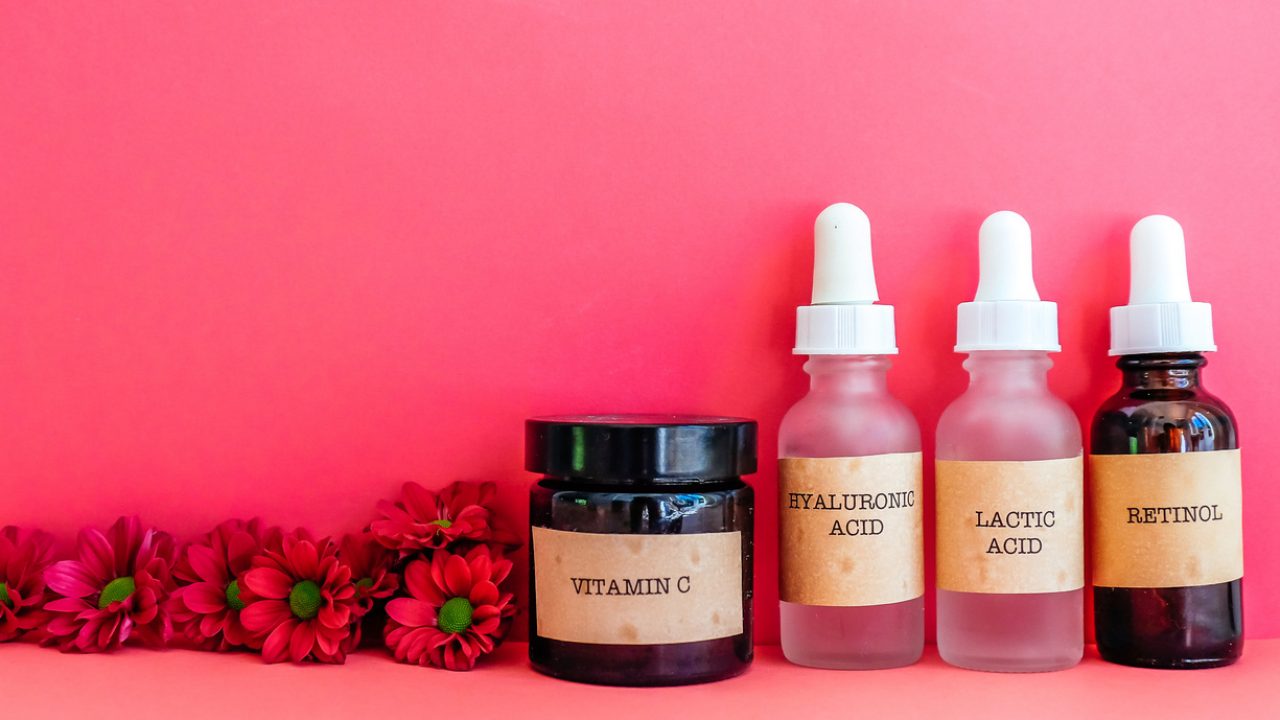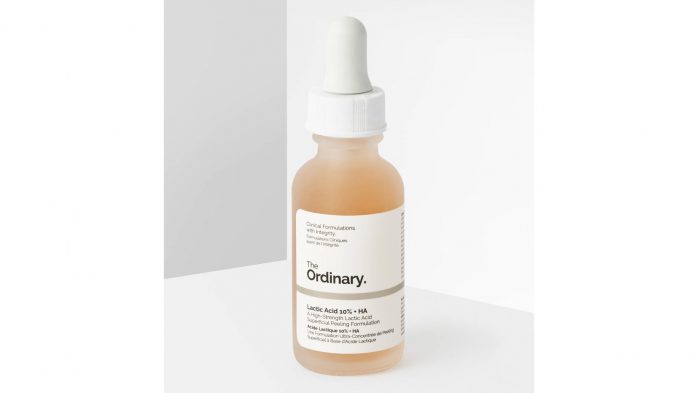
Chances are, if you’ve heard of lactic acid already it was at school when you were learning about how the body converts glucose into energy. However, it’s also an incredibly useful – and popular – skincare ingredient.
Falling into the same category as glycolic acid, which is a well-known exfoliant, lactic acid performs a similar job – it reveals brighter, more even skin tone by getting rid of dead skin cells and congestion.
It’s becoming an increasingly common skincare ingredient, both in its own right and when combined with other ingredients, so in the latest in our Ingredient Spotlight series we take a look at what it is, what it does and how you can incorporate it into your skincare routine.
FURTHER READING: How to layer your skincare
 The Ordinary
The Ordinary Lactic acid is the larger molecule of the alpha hydroxy family, also known as AHAs. If you’re not familiar with AHAs – or BHAs for that matter – they’re compounds that contain hydrogen next to oxygen.
The majority of acids found in makeup and skincare fall within these two main groups of compounds and AHAs are the more complex of the two. This also means they’re the most effective.
Put simply, lactic acid is the gentler alternative to glycolic acid, another acid in the AHA group. It works in a similar way – to exfoliate and remove dead skin cells – but is less abrasive.
We should state that glycolic acid isn’t overly abrasive and is perfectly safe to use, it’s just lactic acid is better suited to people with sensitive skin or those looking to introduce an exfoliant to their skincare order for the first time.
Like other liquid exfoliants, lactic acid reveals brighter, more even skin tone and it also provides additional moisture to the outer layer of your skin.
IS LACTIC ACID VEGAN?
Lactic acid was first discovered in soured milk, hence its name.
Today, however, nearly all the lactic acid you find in food and skincare is derived from cornstarch or beet sugars.
While lactic acid can be produced in dairy products, an estimated 90% produced industrially is done so using vegan, non-dairy ingredients.
The most common way of mass-producing lactic acid is by fermenting carbohydrates.
Lactic acid increases the ceramides in the skin to protect your all important natural skin barrier.
It increases water retention, prevents congestion and improves pigmentation.
This means that not only is it great for boosting your skin in its own right, it can help make your other skincare products more effective.
With lactic acid being a larger molecule, compared to glycolic acid, it concentrates on improving the upper layers and surface of your skin; it gives a lighter and gentle exfoliation to your skin.
This makes it particularly useful for people with dry, reactive and sensitive skin such as rosacea and eczema.
You also need to make sure you’re using an SPF when you use any exfoliant, or active ingredients, as it can increase your sensitivity to the sun’s damaging rays.
As with all exfoliants, there is a chance that your skin will breakout in the first couple of weeks of using a new product.
This is known as skin purging and is normal. If you want to know more, read our Skin purging: What does skin purging look like and how long does it last? guide.
Note: If you do have an existing skin condition, consult a dermatologist or your GP before introducing any new skincare products to your routine.
Lactic acid comes in the forms of cleansers, serums, masks and peels.
Lactic acid cleansers
These are typically gentle enough to use daily morning and night, and are the best way to introduce lactic acid to your routine.
How to use: Apply to a wet face and massage gently for 30-60 seconds. Pat your skin dry – don’t vigorously rub your skin dry.
FURTHER READING: Discover which face cleanser best suits your skin from oily to dry and acne-prone
Lactic acid serums
Use lactic acid serums once a day, primarily in the evening. Apply 2-3 drops to the face in a patting motion and follow with your regular moisturiser.
FURTHER READING: Best face serum: The best performing anti-ageing, hydrating face and eye serums
Lactic acid masks and peels
Masks and peels are a great way to freshen and liven the skin. Lactic acid easily removes dead skin while leaving the skin hydrated, bright and smooth. Just apply a cleansed face, leave on for 2- 3 minutes and wash off.
FURTHER READING: The best face sheet masks from Garnier, Charlotte Tilbury and more
Here is our pick of the best cleansers, serums and masks that help you add lactic acid to your skincare order.
£16 | Buy new from Cult Beauty
Why we love it: Kate Somerville has been a leading skincare pioneer for more than two decades. Launching her brand in 2004 alongside top cosmetic surgeons and dermatologists, Kate opened her clinic in the heart of Hollywood and is now bringing her goods to the UK.
Kate’s exfoliating foaming face wash is gentle enough to use morning and night; it removes makeup, dirt, debris and improves the texture of your skin.
Packed full of Kate’s “three Ps for perfect skin” – papaya, pineapple and pumpkin enzymes – this lactic acid cleanser will naturally enhance your skin without it feeling dry.
Buy now from Cult Beauty
Why we love it: Dermalogica Resurfacing Cleanser is aimed for more mature skin, to give the appearance of youthful skin.
Containing lactic acid as a key ingredient, this cleanser will help hydrate and stimulate cell turnover to give more plump skin. It additionally smoothes out fine lines and wrinkles.
The addition of vitamin E provides nourishment while Rose Flower Oil helps reduce and soothe irritation. This makes this cleanser great for someone with dry, sensitive and acne-prone skin.
Due to the fact this cleanser foams, it makes it ideal as the second cleanser in your evening double cleansing ritual. You can find out more about this in our How to layer your skincare guide.
Buy now from Cult Beauty
£5.50 | Buy now from Deciem
Why we love it: How could we not involve The Ordinary in any guide to the best skincare? It has an incredible range and we know, from personal experience, that the active ingredients inside its bottles really do work as promised.
The Ordinary Lactic acid has a 5% or 10% version and while it may be tempting to dive straight in with the 10%, the 5% version still performs fantastically well, without being too harsh to your skin. This doesn’t mean the 10% causes irritation, it’s just that it’s more likely to.
We use this serum up to twice a week, and only in our evening skincare routine.
Buy now from Deciem
£7.99 | Buy now from Cult Beauty
Why we love it: Another much-loved brand here at mamabella, this gentle exfoliator from The Inkey List helps brighten your skin with the added benefit or evening out your skin tone. All the while keeping your skin hydrated.
This product contains 10% Lactic Acid and 1% of hyaluronic acid, which helps hydrate your skin.
If you have dry/sensitive or eczema-prone skin, this product can cause a slight tingling sensation but little irritation.
Buy now from Cult Beauty

